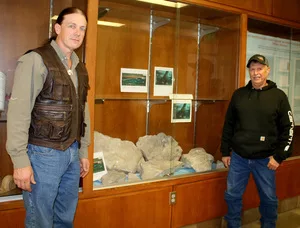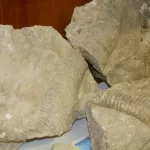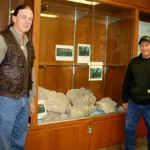
MAYVILLE, N.D. (MSU) – “Hard to believe, but it is true,” said Dr. Michael Kjelland, Associate Professor of Biology at Mayville State University.
“In May, Steele County landowners Shelly and Jay Anderson notified me that Jay had found what they thought might be a fossil turtle shell. I asked to see some photos of it, but even then, I couldn’t quite tell what it was.” After Dr. Kjelland received some of the actual fossil pieces that were found by Jay Anderson, he could tell he was looking at something rather peculiar, something not seen very often in this area, and rarely in such large pieces. “It looked different from what I have observed before, and I immediately knew it was worthy of further investigation. I made a trip to the discovery site to meet up with Jay and check for more pieces of the fossil. Sure enough, we found more.” The fossil was discovered in a gravel pit. A huge boulder had been removed from a depth of about 12 feet or so. Given its size, heavy equipment was used to break the fossil up and remove it from the pit. Once the sedimentary boulder was broken apart, the partial fossil specimen was revealed.
After some research, a meeting with Peter Larson (Black Hills Institute), and further discussion with Javier Ortega-Hernández, invertebrate paleobiologist and curator in invertebrate paleontology at the Museum of Comparative Zoology at Harvard University, it was agreed that this was an Ordovician cephalopod, and more specifically, it appears to be that of Endoceras sp. The fossil is an extinct ancient sea monster, a cephalopod (Class: Cephalopoda) and apex predator of the Ordovician Period in the Paleozoic Era, from approximately 485 to 444 million years ago (Wikipedia, International Commission on Stratigraphy, 2015).
Currently, the specimen is on display in the Division of Science and Mathematics at Mayville State University. Further research efforts will focus on determining how this specimen compares to other specimens, if any, found in the North Dakota State Fossil Collection housed at the North Dakota Heritage Center & State Museum in Bismarck, N.D. “There might be more pieces at this site, but it would require some heavy equipment to remove them,” said Dr. Kjelland. This isn’t the only species of cephalopod ancient sea monster that has been found in North Dakota. The giant squid (Tusoteuthis longa) of the Cretaceous Pierre Shale Formation at the Pembina Gorge is another example (Reference: Hoganson, 2010).
Feature photo: Dr. Michael Kjelland (left) and Jay Anderson stand near the fossil pieces of an ancient extinct sea creature found by Jay in Steele County. The pieces are currently on display at Mayville State University.


